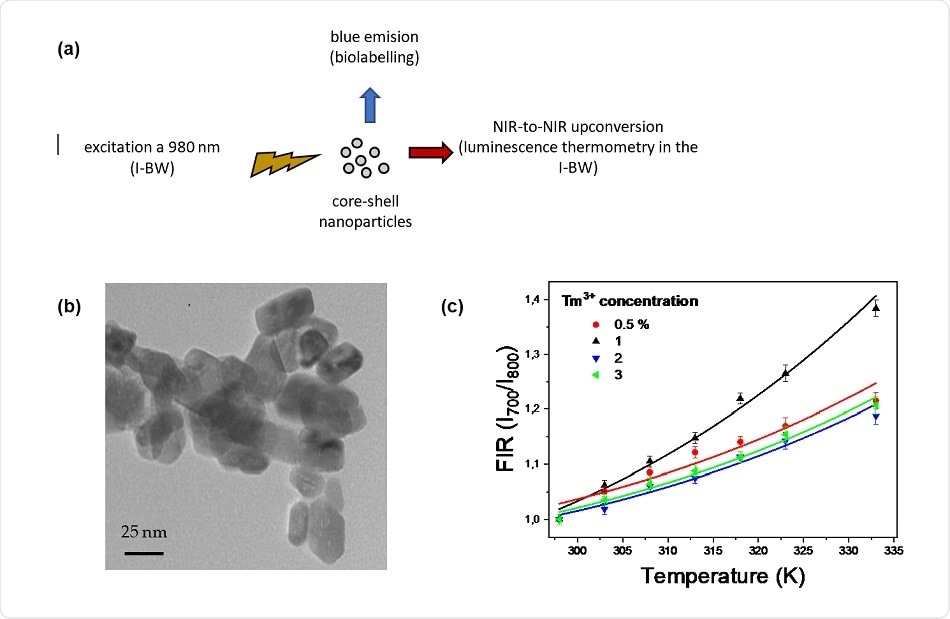A recent study1 undertaken at Rovira i Virgili University in Tarragona, Spain, reveals that biolabeling through luminescence thermometry has the potential to detect cancer cells at an early stage of development, just by monitoring the temperature rise in the body, due to accelerated metabolic activities in abnormal cells.
The Linkam THMS600 stage was used by researchers at the university to study the fluorescence of the nanoparticles that are produced. They used UV-Vis-NIR spectroscopy to characterize the nanomaterial’s emission spectra as a function of temperature, which then allowed them to use the cataloged emissions as in vitro luminescent nanothermometers. The observation of temperature-dependent luminescent particles for use as nanothermometers is made possible by the easy manipulation and chamber control provided by the THMS600, allowing for precise temperature and environmental control of with the ability to image the sample through a wide range of microscopic and spectroscopic techniques.
Our stages are perfectly suited for the analysis of temperature-sensitive materials such as these luminescent particles. They can be used in a range of applications, from biological samples to photovoltaics, where precise temperature accuracy and stability are required as well as the ability to image the sample through microscopy or spectroscopy. This is the case for the research undertaken at Rovira i Virgili University where a wide temperature range and pinpoint accuracy were necessary. Their work provides essential insight into the behaviour of temperature-responsive particles for cancer detection, and we are pleased to help enable such research.
Duncan Stacey, Sales and Marketing Director at Linkam
The researchers placed the sample on top of a boron nitride disk to aid with the uniform and fast distribution of temperature, ensuring that the entire sample is maintained at the same heat. Temperature stability and control is a critical aspect in the calibration of the development of the luminescent nanothermometers, hence the use of Linkam’s precision thermal control stages.
The use of the Linkam THMS600 stage allowed us, among other things, to develop luminescent thermometers operating in the different optical biological windows located in the near infrared part of the electromagnetic spectrum. This is where biological tissues are more transparent to the light, attaining deeper penetration depths which would allow the future treatment of diseases, such as cancer, through laparoscopic techniques. We have also been able to develop thermochromic thermometers, in which the colour of the emission changes in accordance with the temperature, and that can be used as naked eye indicators as to whether industrial processes are progressing correctly or not.
Joan Josep Carvajal Marti, Vice-Dean of the Faculty of Chemistry at Rovira i Virgili University, Spain
The techniques using the THMS600 stage developed by the research team at Rovira i Virgili University enable, for the first time, the measurement of the thermal resistance of a nanoparticle. This is a milestone that opens up research into the thermal properties of nanomaterials, allowing researchers to establish strategies to tailor these properties through the suitable design of the materials. The scientific breakthroughs by this group and others are contributing to the advancement of tools to detect, understand, and treat cancer.

Figure 1 (a) Schematic representation of the pumping and emission bands generated by the Tm,Yb:GdVO4@SiO2 core-shell nanoparticles, to illustrate their practical use as biolabels, with emission in the blue, and luminescent thermometers operating in the first biological window (I-BW). (b): Transmission electron microscope (TEM) image of the annealed Tm,Yb:GdVO4 nanoparticles (NPs). (c): Normalized fluorescence intensity ratio (FIR) as a function of temperature for the Tm,Yb:GdVO4@SiO2 core-shell nanoparticles doped with different concentration of Tm3+.
References
- Savchuk et al. Bifunctional Tm3+,Yb3+:GdVO4@SiO2 Core-Shell Nanoparticles in HeLa Cells: Upconversion Luminescence Nanothermometry in the First Biological Window and Biolabelling in the Visible. Available at: https://doi.org/10.3390/nano10050993
For more details about the Linkam THMS600 stage, visit: www.linkam.co.uk/thms600